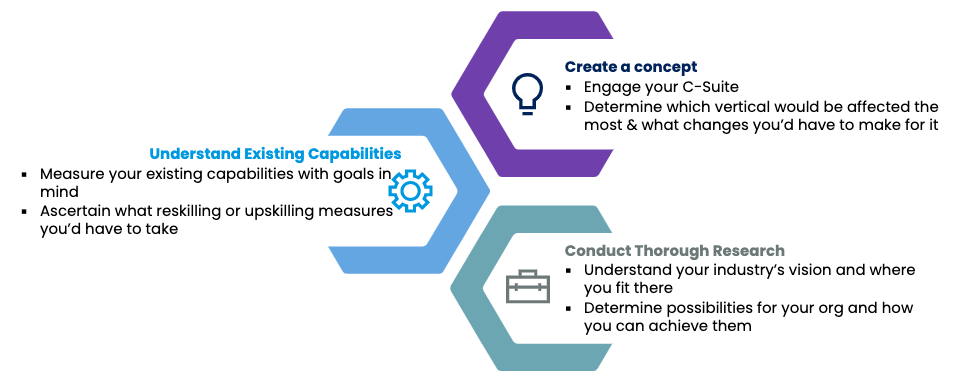Vision is what articulates where you are, where you need to be, and how you’re going to get there. It is what drives your everyday actions and becomes the fulcrum of all strategies.
Amazon’s vision “Selling as Hard as He Can” is simple, transparent, and focused.
Their vision tells everyone involved in the business what to do, i.e., selling.
And that’s exactly what they do.
Amazon continues to add the sources needed to empower their retailers, listing partners, content development teams, payment portals, and everything they require to ‘sell as hard as they can’.
You do everything that needs to be done to achieve that vision.
Why Do You Need to Revisit Your Vision?
Now, with us being the fourth wave of industrial revolution, digital transformation process is imminent. This means that the way your organization works will be altered significantly. And, therefore, vision needs to be reimagined as well.
When people begin with the process, they either begin by optimizing the existing business models or by delegating this task to a separate team, who often remains a disconnected unit within the organization.
But it soon becomes clear to those organizations that effective digitization includes a more fundamental overhaul, and that begins with creating a new vision for your organization.
How Do You Create Your Vision?
Creating a vision would help you in understanding where the market is leading, and how best to adapt to it. To create a vision, however, you need to keep the following things in mind:
- Where your industry, as a whole, is headed
- What fundamental digitization would look for you
- How are you competitors making this transition
- How would the revenue generation be affected
The process, however, isn’t as simple. It would tilt the industry in your favor, propel you towards growth, and could potentially lead to increasing revenue sources. Something as significant as this is seldom simple. The process includes the following steps:

- Create a concept: Any Digital Transformation process begins with a concept, and so does its vision. And that’s where we begin.
Writing a concept requires basic insights. Engage your c-suite and determine how it affects each vertical and dimension of the business. Ascertain which vertical would be transformed first, what changes would you have to make for it, and whether or not you’d need to acquire outside help (be it in the form of tools, partners, or consultants).
As these fundamentals of your business would change, a number of costs would disappear but several would rise too. So, creating a concept would help you in getting on the right path. - Understand existing capabilities: Consider the example of a printing company. They want to venture into 3D printing and require expertise on how they can achieve that. They’d require a number of things: training existing people on how to operate 3D printing machines, hire additional people for help, supply partners.
Moreover, sales and marketing would need alignment as well. They’d have to be taught how to repackage their services to the new market segment.
In a nutshell, understanding and having an accurate measure of your existing resources and workforce capabilities will tell you what reskilling or upskilling efforts you’d have to make. - Conduct thorough research: The new digital business wouldn’t be stationary: it would evolve, it would be dynamic, and it would call for constant innovation. While staying true to the roots, you’d have to determine what possibilities exist for you in the future. Continuing the example of the printing company, they could expand into making parts for machinery, they could partner with fantasy fandoms to create realistic figurines for fans; the possibilities are limitless.
These possibilities determine your vision, and would become the driving force behind digitization as well.
The process would be significant for your strategizing phase as well, as you’d be able to ascertain clear objectives and targets after understanding the market, the industry vision, and how your vision is aligned to it.
A vision can’t be bought to life at once, though. It has to be used as a form of blueprint, using which processes, short term goals, and teams are created.
So, it is vital that you start with a Digital Transformation vision, with up-front thinking that enables digitization realistically.


